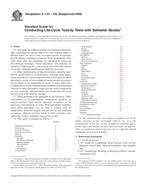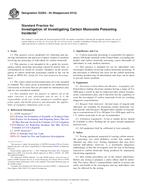Potřebujeme váš souhlas k využití jednotlivých dat, aby se vám mimo jiné mohly ukazovat informace týkající se vašich zájmů. Souhlas udělíte kliknutím na tlačítko „OK“.
ASTM F1687-09
Standard Guide for Terminology and Indices to Describe Oiling Conditions on Shorelines
Automaticky přeložený název:
Standardní Průvodce pro terminologii a indicií k popisu Mazání podmínky na břehy
NORMA vydána dne 1.10.2009
Informace o normě:
Označení normy: ASTM F1687-09
Poznámka: NEPLATNÁ
Datum vydání normy: 1.10.2009
Kód zboží: NS-51170
Počet stran: 5
Přibližná hmotnost: 15 g (0.03 liber)
Země: Americká technická norma
Kategorie: Technické normy ASTM
Kategorie - podobné normy:
Anotace textu normy ASTM F1687-09 :
Keywords:
Observational data/indices, Oil-contaminated shorelines, Oil spill control systems, Shoreline cleaning (of marine environments), Terminology--environmental, ICS Number Code 13.300 (Protection against dangerous goods)
Doplňující informace
| Significance and Use | ||||
|
In order to ensure data consistency, it is important to use standardized terminology and definitions in describing oiling conditions. This guide provides a template for that purpose. Data on oiling conditions at a shoreline are needed to provide an accurate perspective of the nature and scale of the oiling problem and to facilitate spill-response planning and decision making. Data on oiling conditions would be used in assessing the need for cleanup actions, selecting the most appropriate response technique(s), determining priorities for cleanup, and evaluating the endpoint of cleanup activities. Mechanisms by which data are collected may vary (see Guide F1686). They may include aerial video surveys or ground-level assessment surveys. The composition and responsibility of the survey team will depend on the response organization and objectives. The magnitude and type of data sets collected may likewise vary with the nature of the spill and operational needs. Consistent data sets (observations and measurements) on shoreline oiling conditions are essential within any one spill in order to compare the data between different sites or observers, and to compare the data against existing benchmarks or criteria that have been developed to rate the nature or severity of the oiling. To the extent possible, consistency is also desirable between different spills, in order to benefit from previous experiences and cleanup decisions. It is recognized that some modifications may be appropriate based on local or regional geographic conditions or upon the specific character of the stranded oil. |
||||
| 1. Scope | ||||
|
1.1 This guide covers the standardized terminology and types of observational data and indices appropriate to describe the quantity, nature, and distribution of oil and physical oiling conditions on shorelines that have been contaminated by an oil spill. 1.2 This guide does not address the mechanisms and field procedures by which the necessary data are gathered; nor does it address terminology used to describe the cultural resource or ecological character of oiled shorelines, spill monitoring, or cleanup techniques. 1.3 This guide applies to marine shorelines (including estuaries) and may also be used in freshwater environments (rivers and lakes). 1.4 The values stated in SI units are to be regarded as standard. No other units of measurement are included in this standard. 1.5 This standard does not purport to address all of the safety concerns, if any, associated with its use. It is the responsibility of the user of this standard to establish appropriate safety and health practices and determine the applicability of regulatory limitations prior to use. |
||||
| 2. Referenced Documents | ||||
|
Podobné normy:
Historická
1.10.2013
Historická
1.2.2008
Historická
1.4.2008
Historická
1.4.2013
Historická
1.11.2012
Historická
1.10.2010
Doporučujeme:
EviZak - všechny zákony včetně jejich evidence na jednom místě
Poskytování aktuálních informací o legislativních předpisech vyhlášených ve Sbírce zákonů od roku 1945.
Aktualizace 2x v měsíci !
Chcete vědět více informací? Podívejte se na tuto stránku.



 ASTM D7887-13
ASTM D7887-13 ASTM E1191-03a(2008)..
ASTM E1191-03a(2008).. ASTM E1628-94(2008)..
ASTM E1628-94(2008).. ASTM E2230-13
ASTM E2230-13 ASTM E2292-04(2012)..
ASTM E2292-04(2012).. ASTM E2458-10
ASTM E2458-10
 Cookies
Cookies
